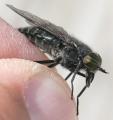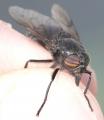Diptera.info :: Miscellaneous :: General queries
Who is here? 1 guest(s)
|
Fly bubble blowing
|
|
| LordV |
Posted on 22-11-2005 08:28
|
|
Member Location: Posts: 673 Joined: 06.09.05 |
I have watched and photographed many different fly species blowing bubbles. Well technically not bubbles- just drops from the end of their tongue which they then suck in again. My current record for the numer of consecutive drops is 11 and the biggest drop was about 2mm in size. Colour ranges from colourless through to dark coffee coloured. Some of the drops even have gas bubbles in. Does anyone know why they do this? Only theory I've heard of is "as an aid to digestion". Interestingly when they do this the flies stay very still and seem to concentrate on what they are doing- they are easier to take pics of. Attached pic of what I think is Scatophaga stercoria doing this. Brian V.  Couple more pics of this behaviour.  
Edited by LordV on 22-11-2005 08:43 |
|
|
|
| Paul Beuk |
Posted on 22-11-2005 09:36
|
|
Super Administrator Location: Netherlands Posts: 19403 Joined: 11.05.04 |
See this thread for my opinion: http://www.dipter...#post_2558. No better suggestions yet and I have not yet taken/found time to investigate further. Paul - - - - Paul Beuk on https://diptera.info |
| LordV |
Posted on 22-11-2005 10:22
|
|
Member Location: Posts: 673 Joined: 06.09.05 |
Thanks Paul, Should have searched first! Anyone else have any views? Brian V. |
|
|
|
| LordV |
Posted on 26-11-2005 08:13
|
|
Member Location: Posts: 673 Joined: 06.09.05 |
New theory on this behaviour. Over the last few cold bright days (air temp around 3-6'C) Every time the sun has actually been bright, I've found all the Scatphaga on one bush in the bright sun were bubbleblowing (around 3-4 of them). I don't normally see bubble blowing at that high frequency. Wonder if it's a way of warming up faster by letting the drop warm up in the sun and then sucking it back in again. Another reason for wondering this is normally flies seem to to sunbathe with their back to the sun (ie head away from the sun), whilst when they are bubble blowing they always seem to be facing the sun or at least at right angles to it, so the bubble is getting full sun. Brian V. Edited by LordV on 27-11-2005 08:20 |
|
|
|
| Andre |
Posted on 26-11-2005 14:20
|
|
Member Location: Tilburg, the Netherlands Posts: 2111 Joined: 18.07.04 |
A remarkable new theory, that does sound quite convincing! Suggestion to everybody: everytime you see a fly acting like this, note the time of day, temperature, sunshine, position of fly towards sun etcetera. Which families/genera are acting like this.... Very nice  |
| LordV |
Posted on 27-11-2005 08:18
|
|
Member Location: Posts: 673 Joined: 06.09.05 |
Thanks for the idea support Andre, only downside of this idea was the danger of the flies setting themselves on fire from the lensing effect of the drops  Only other theory I could think of was that they were aerating their stomach contents to allow aerobic bacterial digestion, but this would not explain the high frequency of observation in cold weather/ bright sun, mind you I'm not sure how much or whether a drop would warm up in the sun. Brian V. |
|
|
|
| Paul Beuk |
Posted on 27-11-2005 10:05
|
|
Super Administrator Location: Netherlands Posts: 19403 Joined: 11.05.04 |
Warming up the bubble could also increase the rate of digestion...
Paul - - - - Paul Beuk on https://diptera.info |
| LordV |
Posted on 27-11-2005 10:31
|
|
Member Location: Posts: 673 Joined: 06.09.05 |
Paul Beuk wrote: Warming up the bubble could also increase the rate of digestion... Very true- still a concept of warming involved. Brian V. |
|
|
|
| Gerard Pennards |
Posted on 27-11-2005 12:57
|
|
Member Location: Amersfoort Posts: 1914 Joined: 07.06.04 |
Dear all, The new theory about the warming sounds perfect, but as always there are exceptions to this. Look at this picture of a buubling fly (Muscidae) that I took in Germany, near to Muenster. It is from the 30th of october this year. The fly is sitting on a treetrunk, but it is not facing the sun! It was sitting on a part that was out of the sun, which was shining at the moment. Greetings, Gerard 
Greetings, Gerard Pennards |
|
|
|
| Nikita Vikhrev |
Posted on 27-11-2005 13:52
|
|
Member Location: Moscow, Russia Posts: 9459 Joined: 24.05.05 |
I have to say, that I absolutly agree with Paul's theory. This theory has all appearence of correct theory, bieng NESSESARY and ENOUGHT. Otherwise we have the problem to explain not only this Gerard's image, but as well the fact that Dragonflies (very warm-loving group) do not bubling, for example. Licking-sucking mouseparts in imago and complet reducing mouseparts in larva lead to external digestion in varios ways. So Diptera bubling. Other insecta do not evolve to external digestion and do not bubling. Nikita Nikita Vikhrev - Zool Museum of Moscow University |
|
|
|
| Gerard Pennards |
Posted on 27-11-2005 15:13
|
|
Member Location: Amersfoort Posts: 1914 Joined: 07.06.04 |
Another idea might be that the flies do this to clean their mouthparts with this fluid, more or less to flush them, and after they are ready they ingest the fluid again! Greetings, Gerard Greetings, Gerard Pennards |
|
|
|
| Ben Hamers |
Posted on 27-11-2005 20:11
|
|
Member Location: Heerlen ( Holland ) Posts: 737 Joined: 16.12.04 |
To make it a little more complicated : I have seen bees bubbling too !? Ben |
| Andre |
Posted on 27-11-2005 20:13
|
|
Member Location: Tilburg, the Netherlands Posts: 2111 Joined: 18.07.04 |
In the light of evolution, it is very well possible that certain diptera-groups (probably closely related to eachother) have developed this behaviour. It could be a mix of reasons. Or the main reason may be digestion, with an extra opportunity to control bodytemperature. To get a better idea of this, best we can do is to make solid observations in the field, like I suggested above. |
| Andre |
Posted on 27-11-2005 20:17
|
|
Member Location: Tilburg, the Netherlands Posts: 2111 Joined: 18.07.04 |
Ben Hamers wrote: To make it a little more complicated : I have seen bees bubbling too !? Ben This could bring up the question: does diet have anything to do with it? Like a diet of farina (= starch?). In what time of year have you seen bees (which species?) doing this? |
| Paul Beuk |
Posted on 27-11-2005 20:37
|
|
Super Administrator Location: Netherlands Posts: 19403 Joined: 11.05.04 |
Andre wrote: In the light of evolution, it is very well possible that certain diptera-groups (probably closely related to eachother) have developed this behaviour. It could be a mix of reasons. Or the main reason may be digestion, with an extra opportunity to control bodytemperature. To get a better idea of this, best we can do is to make solid observations in the field, like I suggested above. I know that both calyptrates and acalyptrates can 'do the bubble'. I cannot recall any orthorrhaphous brachycera and even deep searching my mind I do not recall having seen syrphids do it. I think it may simply also have to do with the structure of the mouth parts that enable the flies to bubble or not. And that, in its turn, is determined by evolution, as related taxa probably have the same kind of mouth parts, unless evolution took the a step further. Paul - - - - Paul Beuk on https://diptera.info |
| Kahis |
Posted on 27-11-2005 21:21
|
|
Member Location: Helsinki, Finland Posts: 1999 Joined: 02.09.04 |
My take: it's a defensive move. At least grasshoppers and some sawfly larvae use regurgitated food as a weapon. They try to spread the sticky, noxious liquid over the attacker. Flies to often regurgitate when caught or disturbed, which makes me think they may be using a similar defensive strategy. Jere Edited by Kahis on 27-11-2005 21:21 Kahis |
| Ben Hamers |
Posted on 27-11-2005 21:38
|
|
Member Location: Heerlen ( Holland ) Posts: 737 Joined: 16.12.04 |
Here is a picture from 07-07-05. It is a male Hylaeus communis (det. Ch. Schmid-Egger) 
Edited by Ben Hamers on 15-05-2006 18:29 |
| Paul Beuk |
Posted on 27-11-2005 22:31
|
|
Super Administrator Location: Netherlands Posts: 19403 Joined: 11.05.04 |
Kahis wrote: My take: it's a defensive move. At least grasshoppers and some sawfly larvae use regurgitated food as a weapon. I have not really noticed it in 'true' flies but in some Nematocera. Since many of the flies observed when blowing bubbles are at rest, I do not think defence will be the major explanation, though I will not rule it out. Paul - - - - Paul Beuk on https://diptera.info |
| LordV |
Posted on 28-11-2005 09:08
|
|
Member Location: Posts: 673 Joined: 06.09.05 |
Kahis wrote: My take: it's a defensive move. At least grasshoppers and some sawfly larvae use regurgitated food as a weapon. They try to spread the sticky, noxious liquid over the attacker. Flies to often regurgitate when caught or disturbed, which makes me think they may be using a similar defensive strategy. Jere Agree with Paul on this, my observations of flies doing this leads me to believe they would actually be wide open to attack, as they are in fact much more approachable when occupied by bubble blowing- they seem to be concentrating so much on what they are doing they become slightly oblivious to the outside world. If true, this would also imply it is an important function because it would seem to have some risk associated with it. Brian V. Edited by LordV on 28-11-2005 09:17 |
|
|
|
| LordV |
Posted on 28-11-2005 14:42
|
|
Member Location: Posts: 673 Joined: 06.09.05 |
Ok just to shoot myself in the foot, spotted a Scatophaga stercoria bubble blowing this AM at an angle of about 120' from where the sun would have been if it was shining. Maybe it's the IR radiation that's important  . . |
|
|
|
| Jump to Forum: |













